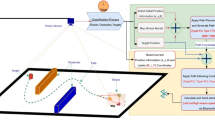Abstract
This paper presents our work on the development of Path Planning Strategy and Navigation by using ANFIS(Adaptive Neuro-Fuzzy Inference System)controller for a vision-based service robot. The robot will deliver a cup to a recognized customer and a black line as the guiding track for navigating a robot with a single camera. The contribution of this research includes a proposed architecture of ANFIS controller for vision-based service robot integrated with improved face recognition system using PCA, and the algorithm for moving obstacle avoidance. We also propose a path planning algorithm based on Dijkstra’s algorithm to obtain the shortest path for robot to move from the starting point to the destination. In order to avoid moving obstacles, we have proposed an algorithm using binaural ultrasonic sensors. The service robot called Srikandi is also equipped with 4 DOF arm and a framework of face recognition system. The proposed path planning strategy and navigation was tested empirically and proved effective.
Similar content being viewed by others
References
T. Tsubouchi and M. Rude, Motion planning for mobile robots in a time-variying environment: A Survey, Journal of Robotics and Mechatronics, vol. 8 no.1(1996), 15–24.
Y.Z. Chang and R. P. Huang, A simple Fuzzy motion planning strategy for autonomous mobile robots, 33rd Annual Conference of the IEEE Industrial Electronics Society, Taiwan, 2008, 477–480.
D. Ito (ed), Robot Vision, Nova Science Publisher, 2009.
W. Budiharto, D. Purwanto and A. Jazidie, Indoor Navigation using ANFIS controller for Servant Robot, 2nd IEEE International Conference on Computer Engineering and Its Application (ICCE 2010), Bali, 2010, 582.586. DOI: 10.1109/ICCEA.2010.119.
H. Kang, B. Lee and K. Kim, Path Planning Algorithm Using the Particle Swarm Optimization and the Improved Dijkstra Algorithm, Workshop on Computational Intelligence and Industrial Application, vol 2 (2008), 1002–1005.
H. Uozumin and Y. Shirai, Mobile Robot Motion Planning considering the Motion Uncertainty of Moving Obstacles, IEEE Int. Conf. on System, Man, and Cybernetics, 1999, 692–698.
J. Kim Pearce and R. Amato, Extracting optimal paths from roadmaps for motion planning, procedding IEEE International Conference on Robotics and Automation, 2003.
H. Li and SX. Yang, A behaviour-based mobile robot with a visual landmark recognition system, IEEE transactions on Mechatronics, vol 8 (2003), 390–400.
D. Rodgriguez and L. Pedraza, “Latest developments in feature based mapping and Navigation for indoor service robots”, Nova Science Publishers, 2009, 123–150.
A. Zhu and S. Yang, “An Adaptive Neuro Fuzzy Controller for Robot Navigation, “Book chapter in Recent Advances in Intelligent Control Systems, Springer, 2009, 277–281.
J.F Canny, The complexity of robot motion planning, MIT Press, Cambridge, MA, 1988.
T. Simeon and J.P Laumond, Manipulation planning with Probabilistic Roadmaps, International Journal in Robotics Research, vol. 23 (2004), 729–746.
E.W. Dijkstra, A note on two problems in connection with graphs, Numerical Math. I (1959), 269–271.
Briggs et al, Expected Shortest Paths for Landmark-Based Robot Navigation, The International Journal of Robotics Research, vol. 23(2004), 717–728.
J.-S. R. Jang, ANFIS: Adaptive-network-based fuzzy inference systems, IEEE Trans. Syst., Man, Cybernetics, vol. 23(1993), 665–685.
J. -S. R. Jang, C.T. Sun, E. Mizutani, Neuro Fuzzy and Soft Computing, Prentice Hall Publisher, 1997.
R. Petru and M. Emil, Behaviour-based neuro-fuzzy controller for mobile robot navigation, IEEE Transaction on Instrumentation and measurement, vol 52, no. 4(2003).
D. Nauck and R. Kruse, Designing neuro-fuzzy systems through backpropagation, In Fuzy Modelling:Paradigms and Practice, Kluwer, Boston, 1996), 203–228.
J.J. Kuffner, K. Nishiwaki, S. Kagami, M. Inaba and H. Inoue, Motion planning for humanoid robots, Proc. 20th Int’l Symp. Robotics Research (ISRR’03), 2003.
B. Stanley and P. McKerrow Measuring range and bearing with a binaural ultrasonic sensor, Proc. of the IEEE/RSJ International Conf. on Intelligent Robots and Systems,vol.2 (1997), 565–571.
Indian database, http://vis-www.cs.umass.edu/~-“vidit/IndianFaceDatabase
Author information
Authors and Affiliations
Corresponding author
About this article
Cite this article
Budiharto, W., Santoso, A., Purwanto, D. et al. A method for path planning strategy and navigation of service robot. Paladyn 2, 100–108 (2011). https://doi.org/10.2478/s13230-011-0019-3
Received:
Accepted:
Published:
Issue Date:
DOI: https://doi.org/10.2478/s13230-011-0019-3




